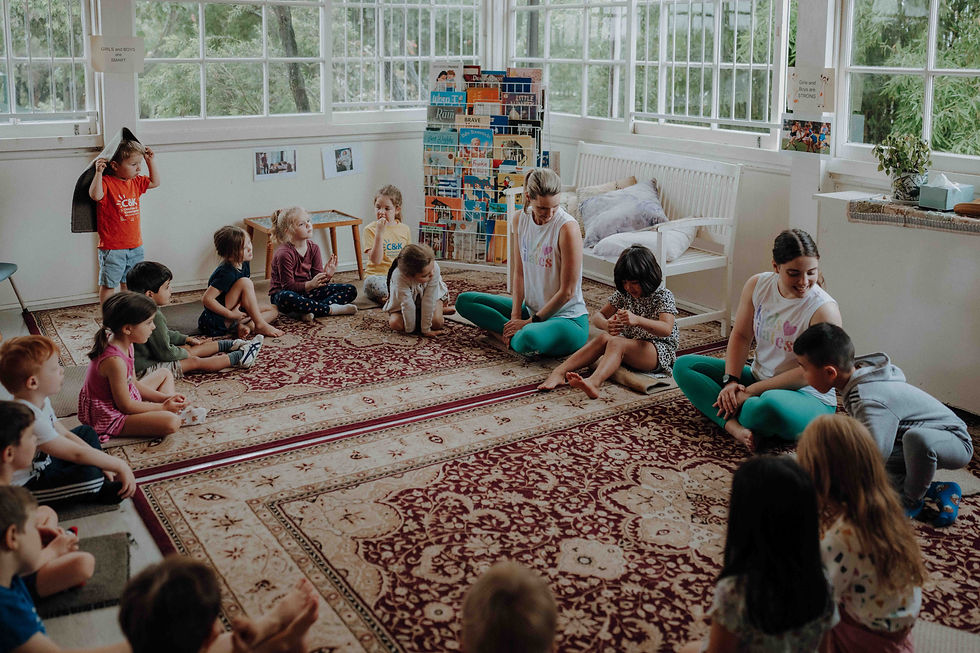Why louder is not better when teaching kids
- Kids Heart Pilates
- Aug 3, 2020
- 4 min read
Updated: Apr 29, 2022

“If my hands are on my head, pop your hands on your head! “
One of my go to Pilates adventure rules to keep us safe and strong.
I have 3 rules for my Pilates adventure that I take kids through at the start of the class. These rules are in place so that we can have fun and get strong safely.
1. Stay on our lilly pads and we do not move our lilly pads
2. If my hands are on my head, stop what you are doing and put your hands on your head.
3. If your hands are on your head then there is no talking.
Pretty basic and easy to understand but effective in engaging them and setting out the expectations from the onset. Kids are pretty cluey, more than what we give them credit for so its really important that we can make their class enjoyable but that we maintain control throughout.
I learnt very early on that louder is not necessarily better when working with a group of children. This is something I had to learn through experience. I know I personally have a big voice, I’m fun and pretty engaging (read big kid) but when my mum (veteran special needs teacher) came and watched one of my classes very early on (10 years ago!!) she gave me some feedback that transformed the way that I taught kids. That feedback was that being loud doesn’t gain control of kids. The louder you are, actually the more hyperactive the children can get which can lead to over excited, restless, a little crazy and out of control. I can tell you right now, you will not be the educators favourite guest or the parents if you are in private practice! At Kids Heart Pilates we promote that we can help with engaging the kids, refocusing them and resetting their attention through our classes so they are ready to concentrate and behave for the rest of their day. So we really have to nail that as the repercussions of failing this is a very short lived working relationship with the centre. So how do we create a calm but engaging vibe with children? Here are a few of my tips!

1. Start high end low – I always like to start high energy and then pop some focussing and calm exercises every 5 mins and always end the class with some calming and mindfulness so I am handing them back to the teacher calm, energised and ready to listen.
2. Use their names and give them positive feedback. I cannot tell you enough times- LEARN THEIR NAMES!!! This is something I try and can generally nail in the first couple of sessions. I make sure this a priority in those first few weeks. I will get a photo list of their names and have it on me and I use their names continuously through those first few classes and then it tends to be locked in. They are so chuffed when you know their name. Or shocked when they are being naughty and when you ask them a question directly, I tell you you’ve never seen them sit up so straight and wide eyed in your life.

3. Use silent techniques like copying positions without using your words. Remember that game when you were young of tapping your head, shoulders and knees copying the teacher and then they would change the order and try and trick you. This is an oldie but a goodie. Or even just the old hands on head always works a treat.
4. Move through the exercises at a good pace – Teaching kids is really different from teaching adults. You need to working through the exercises at a nice pace where they get an opportunity to get it which can take longer than adults, have a go, but that they don’t get bored and start acting out. This is where I find telling a story along with the exercises works a treat. I know one of my Exercise Physiologists, Daisy Welsh likes to play games which is another way to move through the exercises at a good pace.

5. Make it relatable- Balancing on one leg like a ballerina might be a winner for some but wont be for everyone so having a few options of storylines or examples is definitely important. I tend to tell different stories each week and will then focus on what the exercises are good for, be it skate boarding, surfing, dancing or gymnastics. If I have a distracted or disruptive child I will try and find out what they specifically like and then include that into my explanations and watch their face light up with enthusiasm.
6. Build the relationship with the teacher – making a connection with the teacher is so important. Not only for getting feedback on the children and the service but for the success in engaging the kids and running a successful session. Check in with techniques the teacher uses so that you are aligned to what they are doing and can reinforce their strategies.
I cannot highlight how important it is to keep kids in control when teaching them any sort of exercise class. When children are engaged they learn and when you can engage with them; show them you know who they are, you see what they are doing and they can relate to what they are doing, it not only will be a different experience for you but also for them and then their teachers. In my opinion this is the first step in making a change to their life and health so something I am very fortunate to have learned early on. Anyone can be loud, particularly a group of kids.

Comments